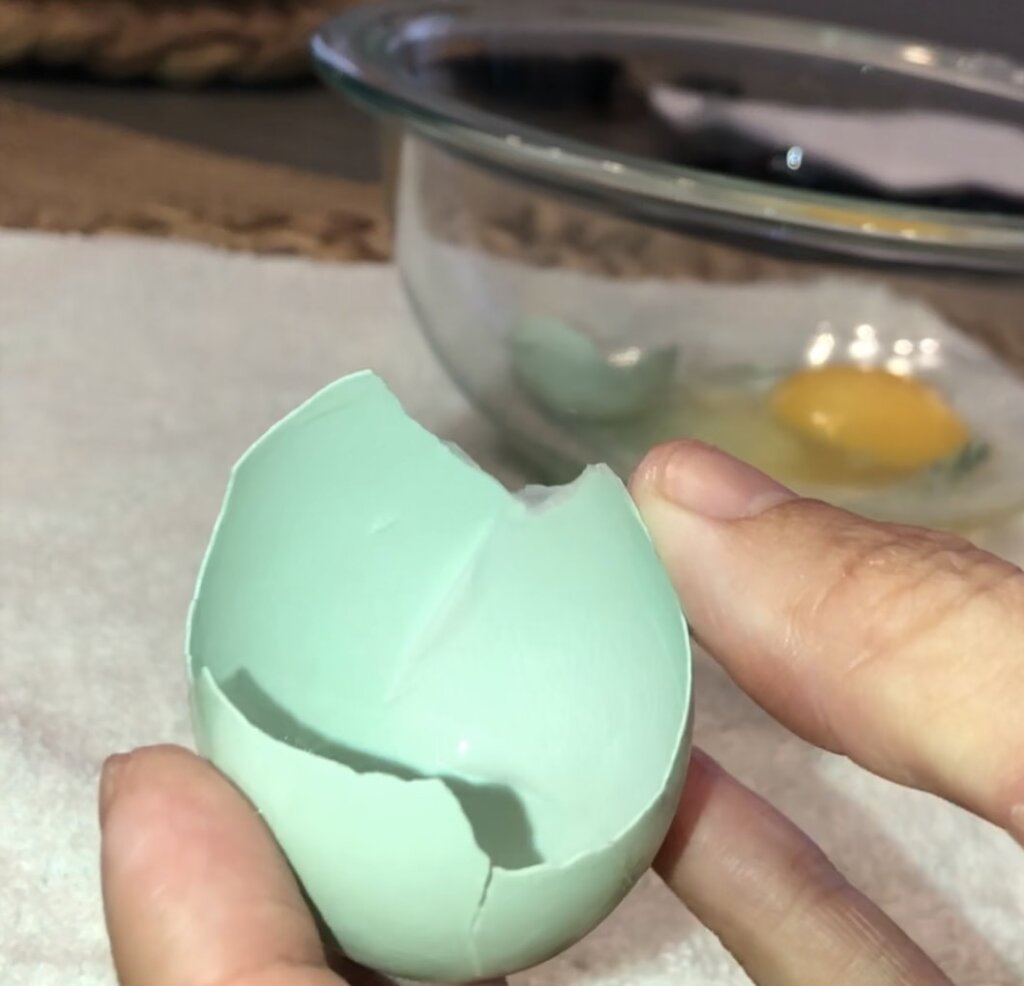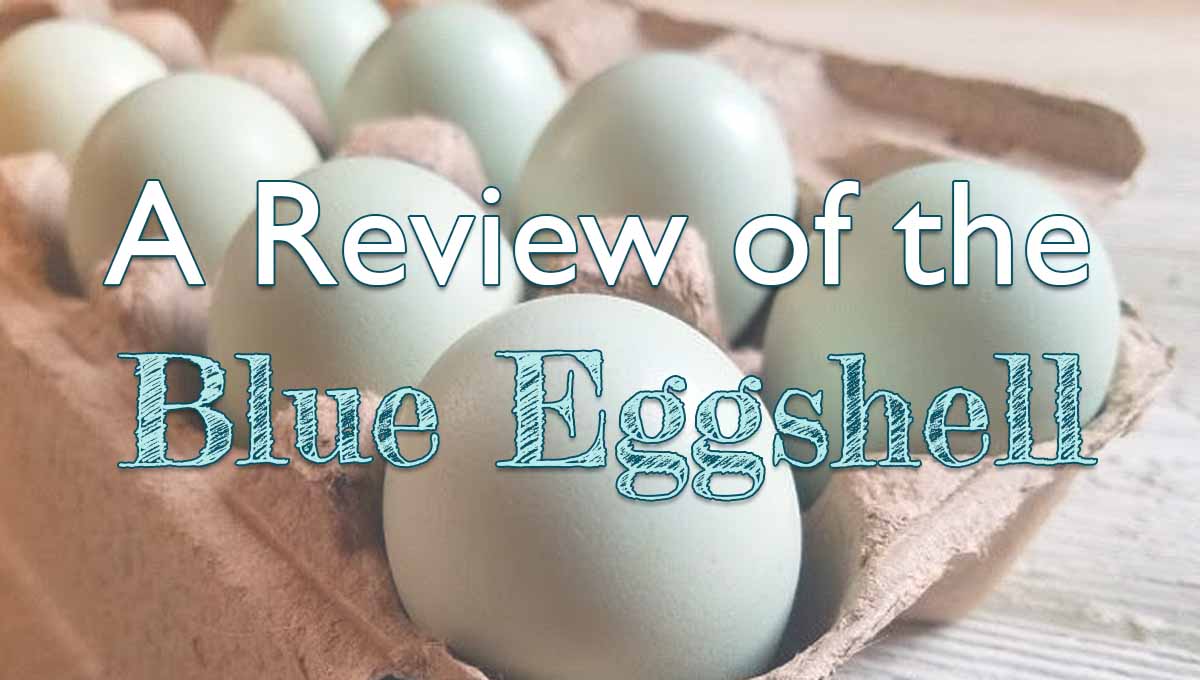by Lindsay Helton

The blue eggshell of an Ameraucana fowl is one of the attributes that draws people to the Ameraucana breed. In this post, the biochemical and physiological characteristics of the blue eggshell are reviewed. Numerous studies and scientific advances have occurred over the years, gradually increasing our knowledge of the blue-green pigments that create the characteristic blue eggshell of an Ameraucana fowl.
The Evolution of Blue Eggshell Pigment Research
It is important to note that the pigment responsible for blue eggshells has been renamed several times over the past century, which may lead to confusion when researching the topic. In the 1800s and several studies since then, the pigment causing blue eggs was referred to as biliverdin. In the late 1800s, H.C. Sorby conducted a scientific study and referred to the same pigment as Oocyan (Sorby, 1875). As scientific advances have occurred, more in-depth studies on eggshell pigments have been completed, and the blue-green pigments responsible for blue eggshells are now identified as biliverdin-IX and zinc biliverdin chelate.
Early Studies on Blue-Green Pigment
Friedrich Tiedemann (1781-1861), a German physiologist and anatomist, was one of the first individuals to study the blue-green pigment now known as biliverdin. He created the now-famous Gmelin reaction (a diagnostic color test) that identified bilirubin in bile. Bilirubin is a derivative of biliverdin (Tiedemann, 1814).
In 1858, W. Wicke presented what is considered the first known chemical essay on egg color pigments. Wicke treated eggshells with hydrochloric acid, water, and boiling alcohol. During the process, he collected and identified a bluish-green pigment, which he declared to be biliverdin (Wicke, 1858).
In 1875, H.C. Sorby published Proceedings of the Zoological Study, the first scientifically based publication on the pigments present in blue eggs. Through spectral analysis of colored eggshells, he identified seven substances in various eggshells, labeling them:
- Oorhodeine
- Oocyan
- Banded Oocyan
- Yellow Ooxanthine
- Rufous Ooxanthine
- Lichnoxanthine
- A substance imperfectly distinguished
Oocyan, meaning “egg blue,” later became known as biliverdin, while Oorhodeine was identified as Protoporphyrin IX, the pigment responsible for brown eggshell coloration.
Genetic Classification of Blue Egg Pigmentation
R.C. Punnett was the first to classify the pigment found on brown eggshells as protoporphyrin and discovered that the blue-green eggshell color in chickens was produced by an autosomal dominant gene called Oocyan. He noted that eggs laid by Oocyan homozygotes were darker blue than those laid by heterozygotes (Punnett, 1933).
Kennedy and Vevers (1973) found that blue eggs laid by Araucanas contained biliverdin-IX, zinc biliverdin chelate, and protoporphyrin-IX. In a 1976 study of 108 Araucana fowl, they confirmed that only biliverdin-IX and zinc biliverdin chelate were responsible for blue eggshell coloration.
In hens that lay olive-green or khaki-colored eggs, a coating of protoporphyrin-IX is deposited onto the eggshell during the final hours in the uterus. Since biliverdin permeates all eight layers of the eggshell, cracking open a blue Ameraucana egg reveals a blue interior as well (Wang et al., 2007).
Understanding the Blue Eggshell Gene
The higher the concentration of biliverdin within the uterus of a hen, the bluer the egg will be, whereas a higher concentration of protoporphyrin-IX results in a more olive or brown hue (Wang et al., 2009). Research has shown that biliverdin is created within the shell gland and deposited onto the eggshell roughly 3-4 hours before oviposition (Wang et al., 2009).
A 2010 study mapped the blue egg allele locus (O), determining that the O locus was located between the A and (tg) n loci at Chr1:67,296,991-69,140,571, marking the first genomic sequence interval established for the blue eggshell gene (Wang et al., 2010).
A 2013 study found that the blue egg phenotype is linked to the SLCO1B3 gene, part of the organic anion transporting polypeptide (OATP) family. The OATPs function as membrane transporters and have been shown to transport bile products such as biliverdin. An EAV-HP insertion in the 5′ flanking region of the SLCO1B3 gene was linked to the blue eggshell phenotype (Wang et al., 2013).
Selective Breeding for Blue Egg Color in Ameraucanas
Many people are unaware that the various Ameraucana color varieties were initially created by crossing birds of different backgrounds and selecting for specific attributes. Blue egg color was one of these key traits. The attributes selected for eventually formed the breed standard for each of the approved Ameraucana color varieties.
The APA standard requires Ameraucanas to have several important attributes beyond blue egg color, including a pea comb, reddish bay eye color, a beard, muffs, and slate shanks. Breeding birds toward the standard of perfection is about balance—focusing solely on one attribute can cause a breeder to lose sight of other important traits.
To improve egg color in an Ameraucana flock, consider toe-punching chicks that hatch from the bluest eggs. If they grow up to be pullets, they will hopefully lay similarly blue eggs. If they grow up to be cockerels, you will have knowledge that they hatched from a well-colored blue egg and likely carry strong blue egg genes.
Conclusion
The science behind blue eggshell coloration continues to evolve, and as new research emerges, we gain a deeper understanding of how pigments like biliverdin-IX and zinc biliverdin chelate function. Breeding Ameraucanas with an emphasis on both genetic integrity and breed standards ensures that future generations of these remarkable birds will maintain their signature blue eggshell color.
Good luck with your Ameraucana flock!
This post was written by Lindsay Helton, and shared with permission from the author. Want to know more about the Ameraucana Chicken? Join the Club! Or ready to add Blue Egg Layers to your flock? Find Eggs, Day-Old Chicks, and Started Poultry in our Shop!



